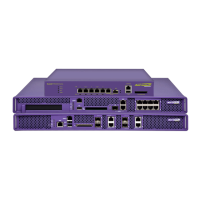Network Setup
Summit WM3000 Series Controller System Reference Guide196
Configuring WMM
Use the WMM tab to review each radio’s current index (numerical identifier), the Access Category that
defines the data type (Video, Voice, Best Effort and Background) as well as the transmit intervals
defined for the target access category.
To view existing WMM Settings:
1 Select Network > Access Point Radios from the main menu tree.
2 Click the WMM tab.
WMM information displays per radio with the following information:
3 Use the Filter Options facility (by clicking the Show Filter Options
link) to specify if information is
filtered by Index (default setting), AP, Access Category, AIFSN, Transmit Ops, CW Min or CW Max.
Select Turn Filtering Off to disable filtering.
Index
Displays the identifier assigned to each Radio index, each index is
assigned a unique identifier such as (1/4, 1/3, etc.).
AP
Displays the name of the Access Point associated with the index. The
Access Point name comes from the description field in the Radio
Configuration screen.
Access Category
Displays the Access Category currently in use. There are four categories:
Video, Voice, Best Effort and Background. Click the Edit button to change
the current Access Category. Ensure the Access Category reflects the
radio’s intended network traffic.
AIFSN
Displays the current Arbitrary Inter-frame Space Number. Higher-priority
traffic categories should have lower AIFSNs than lower-priority traffic
categories. This will causes lower-priority traffic to wait longer before
trying to access the medium.
Transmit Ops
Displays the maximum duration a device can transmit after obtaining a
transmit opportunity.
ECW Min
Displays the ECW Max to make the Contention Window. From this range,
a random number is selected for the back off mechanism. Lower values
are used for higher priority traffic.
ECW Max
Displays the ECW Min to make the Contention Window. From this range,
a random number is selected for the back off mechanism. Lower values
are used for higher priority traffic.

